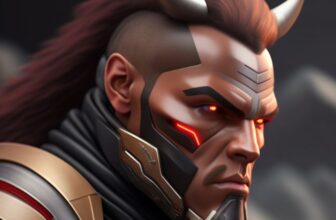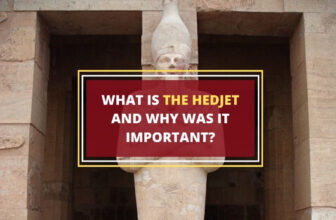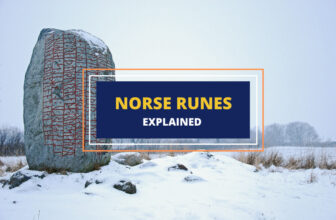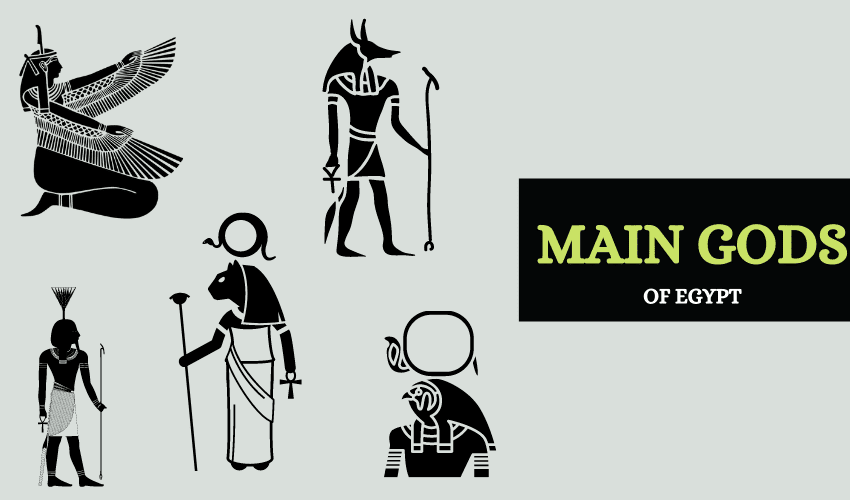
Table of Contents
Egyptian mythology is as gorgeous and fascinating as it is complex and convoluted. With over 2,000 gods worshipped over its history of more than 6,000 years, we can’t cover each and every one here. However, we can certainly go over all the major Egyptian gods.
When reading their descriptions and summaries, it often seems like every other Egyptian god or goddess was “the main” god of Egypt. In a way, that’s true as ancient Egypt had multiple distinct periods, dynasties, areas, capitals, and cities, all with their own main gods or pantheons of deities.
Additionally, when we talk about many of these gods, we usually describe them at the height of their popularity and power. In reality, the cults of many Egyptian deities were separated by hundreds or even thousands of years.
And, as you’d imagine, the stories of many of these gods were rewritten and merged multiple times through the millennia.
In this article, we’ll go over some of the most significant gods of ancient Egypt, who they were, and how they interacted with each other.
Sun God Ra
Probably the first god we should mention is the sun god Ra. Also called Re and later Atum-Ra, his cult started in Heliopolis near modern-day Cairo. He was worshipped as creator god and ruler of the country for more than 2,000 years but the peak of his popularity was during Egypt’s Old Kingdom.
As a sun god, Ra was said to travel the sky on his solar barge every day – rising in the east and setting in the west. During the night, his barge traveled below the ground back east and through the Underworld. There, Ra had to fight off the primordial serpent Apep or Apophis every night. Fortunately, he was helped by several other gods such as Hathor and Set, as well as the souls of the righteous dead. With their help, Ra continued to rise every morning for thousands of years.
Apophis
Apophis himself is a popular deity as well. Unlike giant serpents in other mythologies, Apophis isn’t just a mindless monster. Instead, he symbolizes the chaos ancient Egyptians believed threatened their world every night.
More than that, Apophis demonstrates a major part of Egyptian theology and morality – the idea that evil is born out of our individual struggles with non-existence. The idea behind that resides in Apophis’ origin myth.
According to it, the chaos serpent was born out of Ra’s umbilical cord. So, Apophis is the direct and inescapable consequence of Ra’s birth – an evil Ra is destined to face for as long as he lives.
Amon
While Ra lived on as Egypt’s prime god for quite some time, he still underwent some changes along the way. The biggest and most important one was his fusion with the next of Egypt’s ruler deities, Amon or Amun.
Amun started out as a minor fertility deity in the city of Thebes while Ra still held dominion over the land. By the start of the New Kingdom in Egypt, however, or around 1,550 BCE, Amun had replaced Ra as the most powerful god. Yet, neither Ra nor his cult were gone. Instead, the old and the new gods merged in one supreme deity called Amun-Ra – god of the sun and air.
Nekhbet and Wadjet
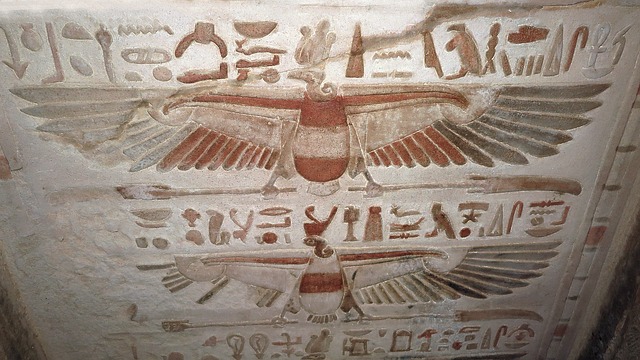
Just like Amun followed Ra, the original sun god himself also wasn’t the first prime god of Egypt. Instead, the two goddesses Nekhbet and Wadjet held dominion over Egypt even before Ra.
Wadjet, often depicted as a serpent, was the patron goddess of Lower Egypt – the Egyptian kingdom at the Nile’s delta on the Mediterranean’s coast. Wadjet was also known as Uajyt in her earlier days and that name kept being used when Wadjet would display her more aggressive side.
Her sister, the vulture goddess Nekhbet, was the patron goddess of Upper Egypt. That is, the kingdom to the south of the country in the mountains through which the Nile flowed north toward the Mediterranean. Of the two sisters, Nekhbet was said to have a more motherly and caring personality but that didn’t stop the Upper and Lower kingdoms from warring quite often through the years.
Known as “The Two Ladies”, Wadjet and Nekhbet ruled over Egypt for almost all of its predynastic period from around 6,000 BCE to 3,150 BCE. Their symbols, the vulture and the rearing cobra, were worn on the headdresses of the kings of the Upper and Lower kingdoms.
Even once Ra came into prominence in the unified Egypt, the Two Ladies continued being worshipped and revered in the areas and cities they once ruled.
Nekhbet became a beloved funerary goddess, similar and often associated with two other popular funerary goddesses – Isis and Nephthys.
Wadjet, on the other hand, also remained popular and her rearing cobra symbol – the Uraeus – became a part of the royal and divine attire .
Because Wadjet was later equated to the Eye of Ra, she became viewed as a personification of Ra’s power. Some also viewed her as a daughter of Ra, in a way. After all, even though she was older historically, Ra’s mythology cites him as a primordial force older than the world.
Bastet
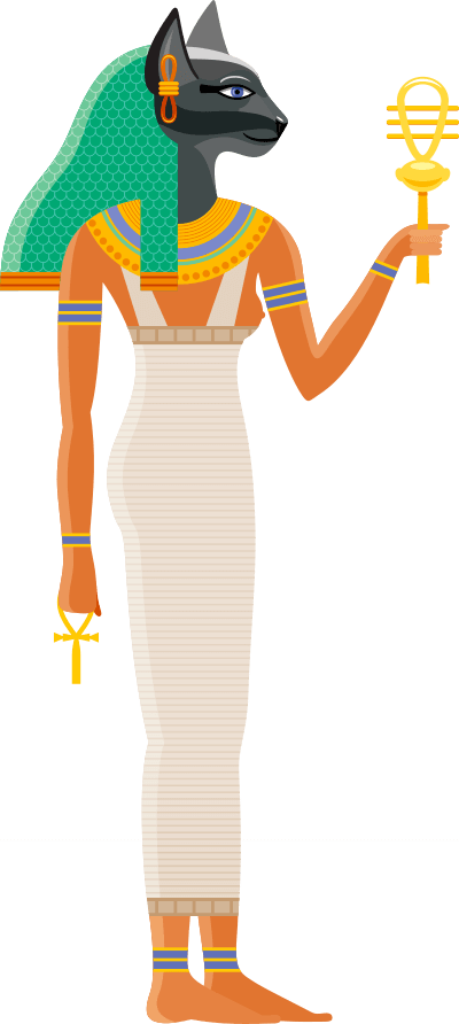
Speaking of Ra’s daughters, another very popular Egyptian goddess is Bastet or just Bast – the famous cat goddess. A gorgeous feminine deity with the head of a cat, Bast is also a goddess of women’s secrets, of the home’s hearth, and of childbirth. She was also worshipped as a protector deity against misfortune and evil.
Even though Bast was never viewed as the most powerful or a ruler deity in Egypt, she was inarguably one of the most beloved gods in the country’s history. Both because of her image as a loving and caring feminine goddess and because of the ancient Egyptians’ love for cats, people just adored her. The ancient Egyptians worshipped her for millennia and always carried her talismans with them.
In fact, the Egyptians loved Bast so much, that their love allegedly resulted in a disastrous and now-legendary defeat against the Persians in 525 BCE. The Persians used the Egyptians’ devotion to their advantage by painting Bast’s image on their shields and leading cats in front of their army. Unable to raise arms against their goddess, the Egyptians chose to surrender instead.
Yet, even Bast might not be the most beloved or famous of Ra’s daughters.
Sekhmet and Hathor
Sekhmet and Hathor are likely the two most famous and convoluted of Ra’s daughters. In fact, they frequently are the same goddess in some accounts of Egyptian mythology. For, while their stories end up being quite different, they start the same way.
At first, Sekhmet was known as a fierce and bloodthirsty goddess. Her name literally translates as “The Female Powerful” and she had the head of a lioness – quite a more intimidating look than that of Bast.
Sekhmet was viewed as a goddess capable of both destruction and healing, yet the emphasis often fell on her destructive side. Such was the case in one of Sekhmet’s most pivotal myths – the story of how Ra grew tired of humanity’s constant rebellions and sent his daughter Sekhmet (or Hathor) to destroy them.
According to the myth, Sekhmet ravaged the land so viciously that the other Egyptian gods quickly ran to Ra and implored him to stop his daughter’s rampage. Taking pity on humanity at the sight of his daughter’s fury, Ra had thousands of liters of beer and dyed it red so that it looked like blood, and poured them on the ground,
Sekhmet’s bloodthirst was so powerful and literal that she immediately noticed the blood-red liquid and drank it at once. Intoxicated with the powerful brew, Sekhmet passed out and humanity survived.
This, however, is where Sekhmet’s and Hathor’s stories diverge because the goddess that woke up from the drunken slumber was actually the benevolent Hathor. In Hathor’s stories, she was the same bloodthirsty deity that Ra sent to destroy humanity. Yet, once she woke up, she was suddenly pacified.
Ever since the blood beer incident, Hathor became known as a patron of joy, celebration, inspiration, love, childbirth, femininity, women’s health, and – of course – drunkenness. In fact, one of her many names was “The Lady of Drunkenness”.
Hathor is also one of the deities that travel with Ra on his solar barge and help fight off Apophis every night. She’s associated with the Underworld in another way too – she’s a funerary goddess as she helps guide the souls of the dead toward paradise. The Greeks even associated Hathor with Aphrodite.
Some depictions of Hathor show her as a motherly figure with the head of a cow which connects her to an older Egyptian goddess named Bat – a likely original version of Hathor. At the same time, some later myths associate her with Isis, the funerary goddess, and wife of Osiris. And yet other myths say she was the wife of Horus, son of Isis and Osiris. All this makes Hathor a perfect example of the evolution of Egyptian deities into one another – first Bat, then Hathor and Sekhmet, then Isis, then Horus’ wife.
And let’s not forget Sekhmet herself, as Hathor wasn’t the only one to wake up hungover from Ra’s red beer. Despite’s Hathor’s emergence from Sekhmet’s drunken stupor, the warrior lioness also lived on. She remained a patron deity of the Egyptian military and wore the moniker “Smiter of the Nubians”. Plagues were also called “Messengers of Sekhmet” or “Slaughterers of Sekhmet”, especially when they struck Egypt’s enemies. And, when such disasters happened to befall the Egyptians themselves, they worshipped Sekhmet once again as she was also the one able to cure them.
Ptah and Nefertem
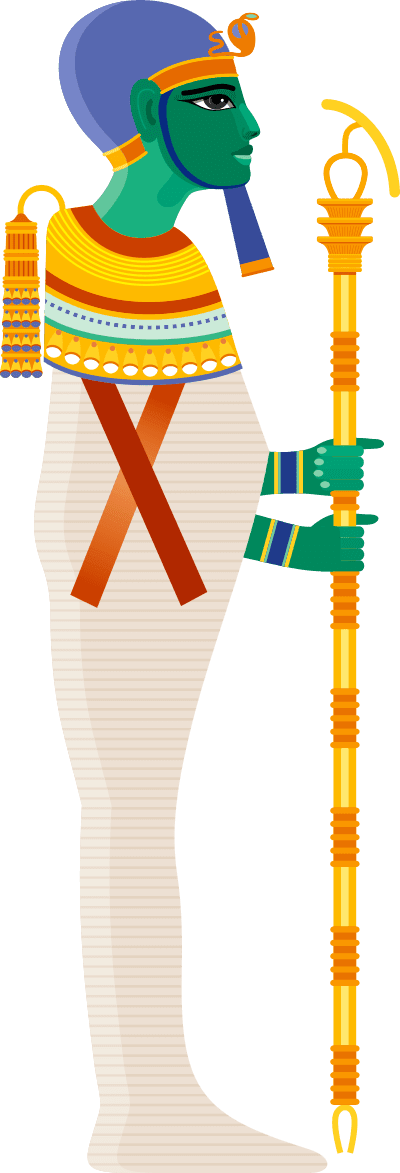
Another important connection Sekhmet leads to is the gods Ptah and Nefertem. Ptah, in particular, may not be as popular today but he was quite pivotal all throughout Egypt’s history. He was the head of a triad of gods worshipped in Memphis together with his wife Sekhmet and their son Nefertem.
Ptah was originally an architect god and a patron of all artisans. According to one of Egypt’s main creation myths, however, Ptah was the god who first created himself out of the cosmic void and then created the world itself. One of Ptah’s incarnations was the Divine Bull Apis which was also worshipped in Memphis.
Curiously, Ptah was the likely origin of Egypt’s name. Many people don’t know this but the ancient Egyptians didn’t call their own land Egypt. Instead, they called it Kemet or Kmt which meant “Black Land”. And, they called themselves “Remetch en Kemet” or “People of the Black Land”.
The name Egypt is actually Greek – originally Aegyptos. The exact origin of that term isn’t a hundred percent clear but many scholars believe that it came from the name of one of Ptah’s major shrines, Hwt-Ka-Ptah.
Osiris, Isis, and Seth
From Ptah and his divine bull Apis, we can move on to another immensely popular family of Egyptian gods – that of Osiris. The famous god of the dead and the Underworld started off as a fertility deity in Abidos. As his cult grew, however, he eventually became associated with Ptah’s Apis bull, and priests at Saqqara started worshipping a hybrid deity called Osiris-Apis.
The fertility god, husband of Isis, and father of Horus, Osiris managed to temporarily ascend to the throne of Egypt’s divine pantheon with the help of his wife. Herself a powerful goddess of magic, Isis poisoned the still-ruling sun god Ra and forced him to reveal his true name to her. When he did so, Isis cured him, but she could now control Ra by knowing his name. So, she manipulated him into retiring from the celestial throne, allowing Osiris to take his place.
Yet, Osiris’ tenure as chief deity didn’t last long. What toppled him off the peak wasn’t the rise of the Amun-Ra cult – that didn’t come until later. Instead, Osiris’ downfall was the treachery of his own jealous brother, Seth.
Seth, a god of chaos, violence, and desert storms, not dissimilar to Ra’s nemesis Apophis, killed his brother by tricking him to lie in a coffin. Seth then locked him inside the coffin and threw it into the river.
Heartbroken, Isis scoured the land, looking for her husband, and eventually found his coffin, grown into a tree trunk. Then, with the help of her twin sister Nephthys, Isis managed to revive Osiris, making him the first Egyptian –god or man – to return from the dead.
Still not fully alive, however, Osiris was no longer a fertility god nor did he continue to reside over the celestial throne. Instead, from that moment on he was depicted as a mummy covered with wraps, with only his face and hands showing their green skin.
In that final transformation of his, Osiris became the god of the Underworld – a benevolent, or at least morally impartial deity who judged the souls of the dead. Even in this state, however, Osiris still remained immensely popular for many centuries – that’s how enamored the Egyptians were with the idea of life after death.
Horus
As for Isis, she managed to conceive a son from Osiris after his resurrection and she gave birth to the sky god Horus. Typically depicted as a youthful man with the head of a falcon, Horus inherited the celestial throne from Osiris for a time and famously fought with his uncle Seth to avenge his father’s murder.
While they didn’t manage to kill each other, Seth and Horus’ battles were quite gruesome. Horus lost his left eye, for example, and it later had to be healed by the god of wisdom Thoth (or Hathor, depending on the account). Horus’ eyes are said to represent the sun and the moon, and so, his left eye also came to be associated with the moon’s phases – sometimes whole, sometimes halved. The symbol of the Eye of Horus is also thought to be a powerful source of healing.
Seth himself lived on as well and remained known for his chaotic and treacherous nature and his bizarre long-snouted head. He was married to Nephthys, Isis’ twin sister, and together they had a son, the famous embalmer god Anubis. Nephthys is often overlooked as a deity but, as Isis’ sister, she is quite fascinating.
Nephthys
The two are said to be mirror images to one another – Isis represents the light and Nephthys – the dark but not in a necessarily bad way. Instead, Nephthys’ “darkness” is seen as just a balance to Isis’ light.
Granted, Nephthys did help Seth kill Osiris in the first place by impersonating Isis and luring Osiris into Seth’s trap. But the dark twin then redeemed herself by helping Isis resurrect Osiris.
Both goddesses are viewed as “Friends of the dead” and as mourners of the dead.
Anubis
And while we’re on the subject of benevolent gods of the dead, Seth’s son Anubis isn’t viewed as an evil deity either.
Wearing the famous jackal face from countless Egyptian murals, Anubis is the god who cares for the dead after their passing. Anubis is the one who embalmed even Osiris himself and he continued to do that with all other dead Egyptians who went before the god of the Underworld.
Other Gods
There are several other major/minor gods of Egypt that haven’t been named here. Some include the ibis-headed god Thoth who healed Horus. He is described as a lunar god and son of Ra in some myths, and as a son of Horus in others.
The gods Shu, Tefnut, Geb, and Nut are also incredibly pivotal for the entire creation mythology of ancient Egypt. They are even a part of the Ennead of Heliopolis together with Ra, Osiris, Isis, Seth, and Nephthys.
Wrapping Up
The pantheon of Egyptian gods is fascinating in their varied mythologies and backstories. Many played critical roles in the day-to-day lives of the Egyptians and, while some are convoluted, complex, and conflated with others – they all remain an integral part of the rich tapestry of Egyptian mythology.





